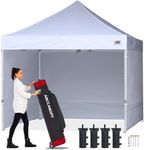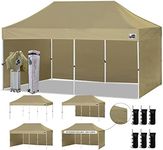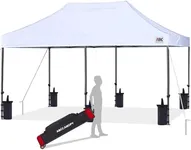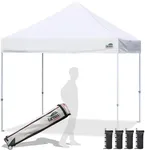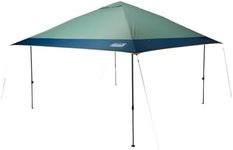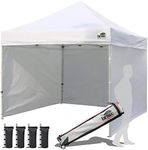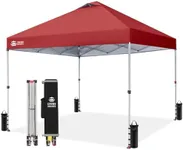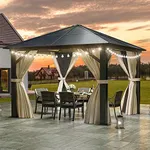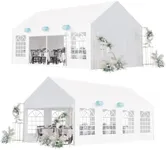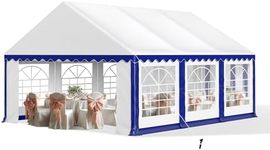Buying Guide for the Best Pop Up Canopies
When selecting a pop-up canopy, it’s important to consider the environment where you’ll use it, how frequently you’ll need to set it up and take it down, the size of your group, and your transportation method. Generally, you want a canopy that is simple to assemble, durable for outdoor conditions, and provides enough coverage for your intended use, whether it’s for a backyard party, market stall, or beach outing. Understanding key features will help you find the best fit for your needs and ensure you get many seasons of reliable use.SizeSize refers to the dimensions of the canopy when it is fully set up. This is important because it determines how much shaded space you have and how many people or tables you can fit underneath. Common sizes range from small 6x6 feet canopies for individual use or small groups up to large 10x20 feet options for bigger gatherings. To choose the right size, think about how many people or what activities you need covered. For solo camping or a couple of people, a small canopy may suffice, while for group events or vendor stalls, a larger one is usually better.
Frame MaterialThe frame material is what gives your canopy structure its strength and support. It’s usually made from steel, aluminum, or a blend. Steel frames are heavier but tend to be stronger and more stable in windy conditions, making them great for longer stays or rough weather. Aluminum frames are much lighter and easier to carry, which is helpful if you need to transport the canopy regularly, but they might be less sturdy during storms. Depending on whether you prioritize portability or durability, you can pick the frame material that matches your typical setup scenario.
Canopy FabricCanopy fabric covers the top and sometimes the sides, providing shade and protection from the sun and light rain. The most common materials are polyester and polyethylene. Higher-denier fabrics (a measure of thickness) are more durable and offer better protection but can be heavier. UV protection and water resistance are key qualities to look for—important for sunny beaches or unpredictable weather. For regular, outdoor family gatherings, you’ll want the thickest, most weatherproof canopy fabric you can find; for occasional use, a lighter one might be enough.
Portability and WeightPortability relates to how easy it is to move and transport your canopy. Heavier canopies offer more stability but are harder to carry, while lightweight models are easier to move but might require extra anchoring. If your canopy will stay mostly in one place, weight may not be a problem. However, if you’ll be frequently carrying it to different locations—like parks, beaches, or fairs—look for a lighter model that comes with a carrying bag and possibly wheels.
Ease of SetupEase of setup describes how quickly and simply you can put up and take down the canopy. Some models boast one-person instantaneous setup with push-button or pull-pin systems, while others may require two people and more effort. For frequent or solo use, a canopy designed for easy or 'pop-up' setup will save time and frustration. If you usually have help or plan to leave the canopy assembled, a more complex model may still work for you.
Stability and AnchoringStability and anchoring features help keep your canopy secure in wind or uneven terrain. These may include stakes, ropes, sandbags, or weighted legs. The more exposed the area, the more you’ll need strong anchoring. For calm backyards, simple stakes may suffice, but for beaches, parks, or windy locations, seek canopies that offer additional stability options to prevent accidental movement or collapse.
Height AdjustmentHeight adjustment means you can set how high the canopy stands. Most pop-up canopies offer a few height settings. Taller canopies give more headroom, which is useful for vendors or spots where people will be standing and moving around, while lower settings can be useful for extra wind resistance or sitting around picnic tables. Choose based on the type of activity—sports sidelines might benefit from taller canopies, while cozy seating areas could be fine with lower ones.

